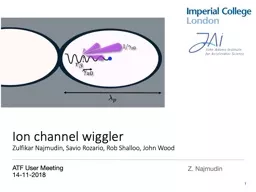

Rozario Rob Shalloo John Wood ATF User Meeting 14 1 1 201 8 1 Z Najmudin Scientific Case 2 Cole J M et al Proc Natl Acad Sci 201806041802314115 Kneip S et al ID: 830388
Download The PPT/PDF document "Ion channel wiggler Zulfikar Najmudin, ..." is the property of its rightful owner. Permission is granted to download and print the materials on this web site for personal, non-commercial use only, and to display it on your personal computer provided you do not modify the materials and that you retain all copyright notices contained in the materials. By downloading content from our website, you accept the terms of this agreement.
Slide1
Ion channel wigglerZulfikar Najmudin, Savio Rozario, Rob Shalloo, John Wood
ATF User Meeting14-11-2018
1
Z. Najmudin
Slide2Scientific Case2
Cole, J. M. et al. Proc. Natl. Acad. Sci.
,
2018/06/04/1802314115
Kneip
, S.
et al.
Nat. Phys.
6, 980–983 (2010).
Slide3Scientific Case3
Whittum
D. et al. Phys. Rev. Lett.
64, 2511 (1990).
Ion channel can be produced by either intense particle or laser beam
At
n
e
≈ 10
17
cm
-3
,
E
y ≈ 1011 Vm-1 (∼ B≈300 T)𝜆𝛽≈1.8 mm, zR ≈ 3 mm ⇾ guiding desirable𝜔c ≳ 1000 𝜔0
⇾ radiation in UV
Slide4Experimental Setup4
Slide5Plans – Guided propagation5
spot size
67 µm
Pulse duration
1.5 ps
Energy
3 J
Wavelength
9.2 µm
z
R
1.6 mm
n
e
1.9 ×1018 cm
-3
At
P/
P
cr
> 1, pulse prone to instabilities
⇾ guiding channel desirable
Try to keep
a
0
<1, but big channels preferable ⇾ only CO
2
laser suitableCould potentially use hydrodynamically formed channels
Slide650
μm
Hydrodynamic channels
R. J. Shalloo, C. Arran et.
al.
, Phys. Rev. E, 97 053203 (2018)
On Axis Density vs Fill Pressure
HOFI Plasma Channel Expansion
Plasma Parameters
Plasma waveguides formed in H
2
Low On-Axis densities ~ 10
17
cm
-3
Matched Spot Sizes ~ 10’s microns
Laser Parameters
Low-energy required: 10-70
mJ
@ 50 fs
Formed with Lens or Axicon
Slide7Radiation from ion channels
7
Radiation from channel guided electrons observed on Vulcan PW
Strongest radiation observed when electrons experience large transverse kicks due to DLA
Kneip
, S. et al. Observation of Synchrotron Radiation from Electrons Accelerated in a Petawatt-Laser-Generated Plasma Cavity. Phys. Rev. Lett. 100, 105006 (2008).
Slide8Plans8
Experiment waiting for laser and electron beam upgrades, and new appointments.
First experiment to test laser beam guiding – can we make hydrodynamic channels?
Secondary goal will be to co-propagate electron beam, and measure its betatron motion as function of gas cell length.
New gas cell being developed to allow variable length
Second period would concentrate on radiation detection
Slide9Parameter
NominalRequested
Beam Energy (MeV)50-6565 MeVBunch Charge (
nC)0.1-2.0
Begin with low chargeCompressionDown to 100 fs (up to 1 kA peak current)Ideally short pulse (~100 fs)
Transverse size at IP (sigma, um)
30
–
100 (dependent on IP position)
Small transverse size is desirable (~10 µm)
Normalized Emittance (um)
1 (at 0.3
nC
)Low is better!
Rep.
Rate (Hz)
1.5
Synchronized to laser shots
Trains
mode
Single bunch
Single Bunch
Special Equipment:
Please indicate any special equipment that you expect to need, including (but not limited to) the transverse deflecting cavity, shaped bunch using mask technique, plasma capillary discharge system, bolometer/interferometer setup etc.
Electron Beam Requirements
Slide10The following options are available at the laser source. Note that the maximum power available at your experiment interaction point will depend on the laser transport method.OPTION 1 (full power, ~1 shot per minute)
isotopic gas in final amplifier
2 TW max (2 ps, 4 J, single pulse)Need relaxed focussing
~ 100 µm – a
0 ~ 1 would be desirableM^2 ~2linear polarizationWould like secondary beam for forming hydrodynamic channels (either
ps
YAG or fs Ti:sapphire)
Would like to try to probe interaction with secondary beam too.
** Please note any specialty laser configurations here **
Interaction Point location: Laser room/electron experiment hall
- delete as necessary (the highest peak power can be delivered to the laser room chamber and 2 beamline #1 chambers. CO
2
laser delivery to beamline #2 will see lower power due to necessary transport in air.)
CO
2
Laser Requirements
10
Slide112019 Experiment Time EstimatesRun Hours (include setup time in hours estimate):Number of electron beam only hours: 0
Number of CO2 laser hours delivered to laser experiment hall (”FEL room”): 50Number of CO2 laser hours, + ebeam, delivered to electron beam experiment hall:
50Overall % setup time: 50%Hazards & installation requirements:Large installation (chamber, insertion device etc…): NLaser use (other than CO
2): YCryogens: NIntroducing new magnetic elements: Y?Introducing new materials into the beam path: N
Any other foreseeable beam line modifications: NPlease describe further where necessary11